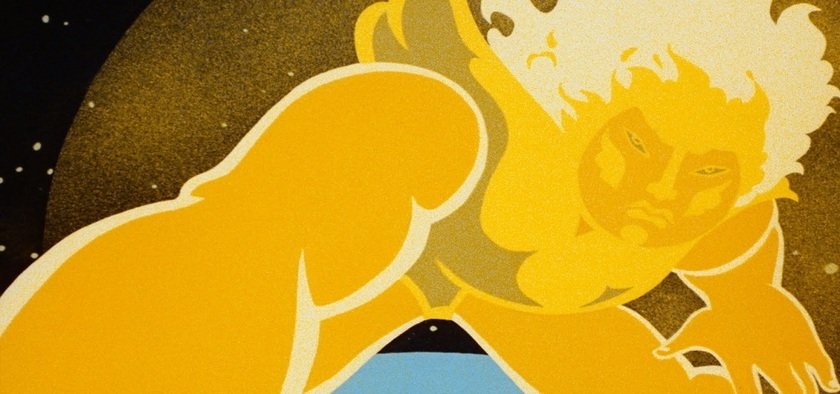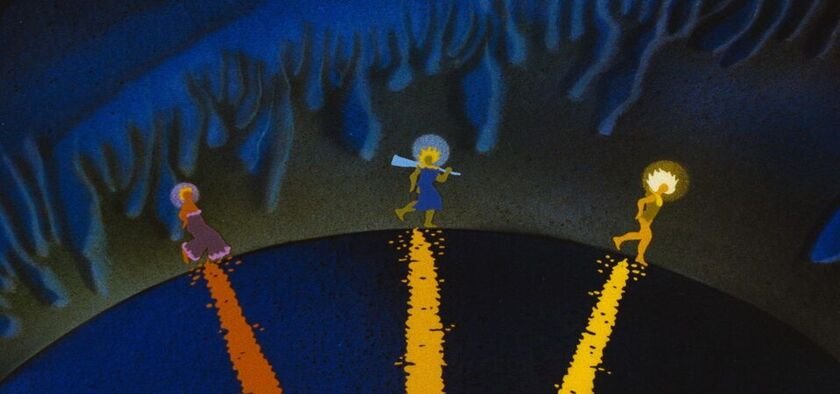
(If you like what you see, you can go to camseyeview.biz to see more of my work on video game reviews, editorials, lists, Kickstarters, developer interviews, and review/talk about animated films. If you would like, consider contributing to my Patreon at patreon.com/camseyeview. It would help support my work, and keep the website up. Thanks for checking out my work, and I hope you like this review!)

Sometimes it just needs to be said how cool and wonderful the medium of storytelling is with animation. Of course, as someone who tackles animation as his main identity as a writer, it is very obvious to me how awesome it is, but sometimes, instead of focusing on the newer films that are getting made, you need to traverse back in time to a different country to really get a kick in how experimental and wonderful this medium can be. The entire world of animation is filled with amazing directors, writers, artists, storyboarders, editors, and so on and so forth. Every part of the world is making animation for some crowd, whether it be for families, teens, adults, or everything in between. With the revolution of animated films starting to diversify their visual styles and tools behind the scenes, it’s good to know that it has always been a thing, and we just never knew about it, or their existence was known by a limited number of people. It’s why we need more distributors and creatives to try to make foreign animated films more readily available to watch, since when you have a film like 1981’s Son of the White Mare, that kind of film needs to be seen by every animation fan.

Based on the Hungarian folk tale by László Arany, this animated adaptation is directed by Marcell Jankovics and produced by Pannonia Film Studio. We follow a young boy who is born from a horse, as he grows to become stronger to take down the three dragons that plague the land and have kidnapped three princesses. Along his adventure, he meets his two brothers and then sets off down below the earth to face the challenges that may face them.

Let’s get one thing clear, this is a folktale. It’s not going to use real-world logic in how it tells its story. Sure, it does do a lot of moments where it tells its story by having our lead go through it or the characters going through it multiple times, but that never gets distracting. Understandably, you can see how it unravels, showing our lead in the best light at every twist and turn. Thankfully, our characters are superbly likable in terms of old-school macho iconography. Our lead truly wants to save the day, and the other brothers are either confident or earnest in their endeavors. Not to say there is nothing of substance to them or the story, since even though it is a folktale/fairy tale, you can still add commentary and thematic elements to the characters. This can be seen when the three dragons are shown. Sure, they don’t look like normal dragons, but their designs are truly out of this world as they cover themes of human greed, war, and capitalistic/corporate/technological growth. It’s a straightforward story that wears its purposeful story on its sleeve, and lets the visuals tell a story with the dialogue being fairly simple, but sometimes that’s all you need for a story like this. Animation is a visual storytelling experience, and while it does get a little tiring with how the story repeats or does the “we are going to do this scene but three times” thing, it changes each encounter up enough to keep pushing the story forward and the folktale sensibilities feel refreshing and not irritating. Many times, audiences demand complex and or philosophical stories, but there are times when simple but well-executed stories will win out.

What also helps keep things moving and invigorating is the animation. This is hands-down one of the best looking and best animated films not just of the 1980s, not just of 1981, but of all time. The amount of creative imagery and designs on display result in a film with a visual look and tone that can not be matched. Instead of trying to look like typical animated films of the time or ripping off Disney’s iconic visual look, the more psychedelic visuals offer something very particular. They don’t have traditional designs, but are more shape-based. Even with how they make everything look, it’s never too busy or where you don’t get exactly who or what everyone is. This visual look was once again done after the director saw the Yellow Submarine film and then crafted one of the most wild-looking fantasy films of the 1970s and of the world of animation, Johnny Corncob. Even when the characters or creatures expand or shift their visual look, you can tell what they are or what they represent in terms of the themes of the story. Often, the visuals help portray the emotional state of the scene, and it brings up moments that will make one think of films like Fantasia. Even the look of the chains and what they are is so awe-inspiring with how creative they appear and how ‘out there’ the overall film is. We truly don’t get films that are created like this anymore or are given the chance to be made like or look like this and that’s a shame. With the evolution of 2D and CGI animation, you would think more studios would want to try out something like this. The voice cast is good, but it was hard to find more info on the cast that didn’t include Gyorgy Cserhalmi, Vera Pap, and Gyula Szabo. Then again, this is what happens when we live in a world where a lot of cinema from around the world is not readily available to people to watch in order to get to know more about the actors involved. The film does have a soundtrack by Istvan Vajda, and it results in a very moody and atmospheric vibe that gives off an eerie tone to a lot of the film. It’s not typically bright or fantastical. It leans more into the dire and dramatic, but that just adds to the identity of this film and why it rocks.

Son of the White Mare is nothing short of awe-inspiring in the world of animation. It covers a lot of the basis for a film that defines itself as a modern piece of classic cinema. It has a visual style to call its own, a straightforward folktale-like experience with some substantial themes and commentary hiding among its vibrant visuals, and it enraptures you in one of the most distinct cinematic adventures ever made. For the longest time, this film was not widely available in any degree in the US, but thankfully Arbelos Films did a 4K restoration of this film and is now available to purchase on Blu-ray. It makes you wonder how the animation landscape would have changed or been different if we were able to get more films like Son of the White Mare in terms of how it told its story and portrayed their emotions through its visuals. Not that it needed to have the same visuals, but in terms of how its animation conveys its words and storytelling. On the other hand, what makes Son of the White Mare special is how it stands out from animation back then and even now. The fact someone took the chance to make this film reminds me and should remind everyone in the industry that all it takes is, as Spider-Verse puts it, a leap of faith to try something new and truly unmistakable.
Rating: Essentials